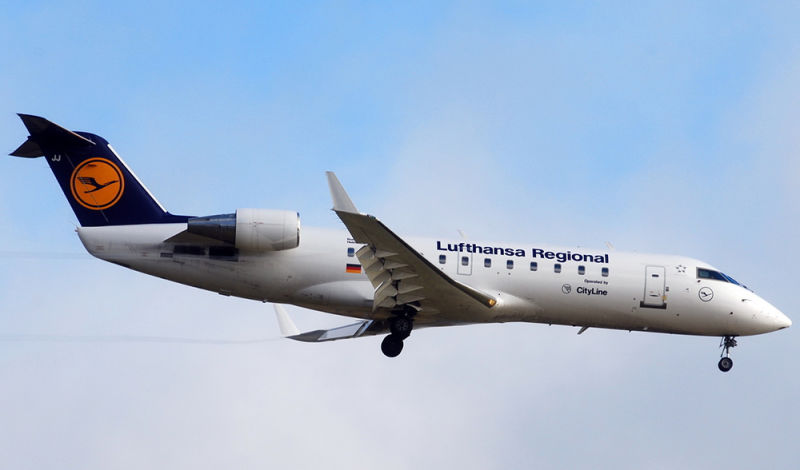Welcome to This Date in Aviation History, getting of you caught up on milestones, important historical events and people in aviation from May 9 through May 12.
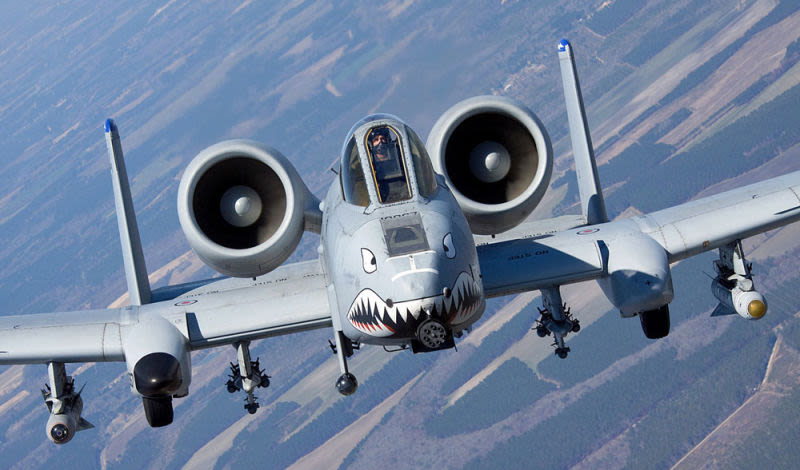
May 10, 1972 – The first flight of the Fairchild Republic A-10 Thunderbolt II. On the night of August 20, 1968, half a million Warsaw Pact soldiers and thousands of tanks and armored vehicles rolled into Czechoslovakia and took control of the country in a single night, putting an end to the political reforms known as the Prague Spring. That watershed event in the Cold War confirmed to the West that the massed might of Soviet armor was a serious and perhaps imminent threat, one that land power alone was not prepared to counter. It would take a combination of land and air power to stop the hordes of Soviets tanks that might invade Western Europe but, at that time, NATO had no dedicated, tank-busting aircraft in its inventory.
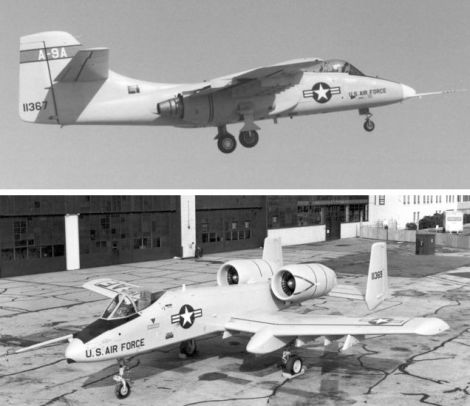
Designers found ample inspiration for how such an aircraft might look from the experiences of the Second World War. One of the first tank busters, the Hawker Hurricane Mk IID, was a regular fighter armed with a pair of 40mm cannons which proved devastatingly effective against German tanks. For their part, the Germans developed the heavily armed though not very maneuverable Henschel Hs 129, the first aircraft specifically designed for close air support. But the move to jet fighters after the war saw the rise of multi-role fighters, ones that could both intercept enemy aircraft and attack ground targets. However, these aircraft were somewhat of a compromise, and not necessarily the best solution for one scenario or the other. By the Vietnam War, the only dedicated close air support (CAS) aircraft in the Air Force inventory was the Douglas A-1 Skyraider, a remarkably capable aircraft, but one that traces its origins back to the Second World War. The NATO allies realized that they needed a purpose-built CAS aircraft, one that could fly low and slow over the battlefield, be rugged enough to sustain battle damage and bring its pilot home alive, and have sufficient firepower to knock out a tank in a single pass.
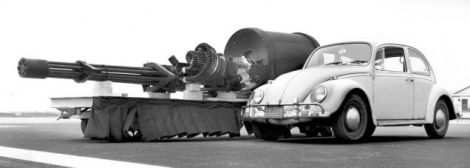
In 1966, the US Air Force created the Attack Experimental (A-X) program office to develop a suitable aircraft, and by 1970 a specific request for proposals was made to the defense industry. Though the new CAS aircraft would be jet-powered, the Air Force emphasized accuracy and firepower over speed. It would fly at no more than 460 mph, but it would also be capable of carrying 16,000 pounds of external stores (by comparison, a loaded Boeing B-29 Superfortress carried 20,000 pounds of bombs). Most importantly, the new aircraft would be developed around the massive General Electric GAU-8 Avenger 30mm cannon, a seven-barrel Gatling gun that could fire over 4,000 rounds of depleted uranium bullets per minute. Compared to other guns in use in CAS aircraft at the time, the Avenger had twice the range, took half the time to reach the target and could deliver three times the mass of projectiles to the target.
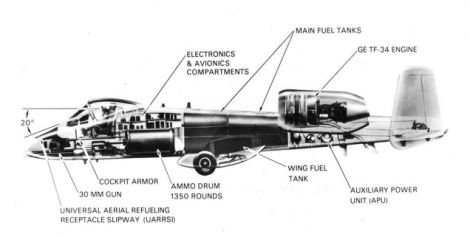
The Air Force selected two finalists, the Northrop YA-9 and the Fairchild Republic YA-10. The YA-9 was a relatively traditional aircraft with fuselage-mounted engines and a shoulder wing, roughly comparable to the Russian Sukhoi Su-25. The YA-10, however, was a radical departure from traditional design, with a low, straight wing that provided excellent low-speed maneuverability, engines mounted in pods above the fuselage to protect them from ground fire, and twin tail fins for redundancy. Twelve hundred pounds of titanium armor formed a tub that protected the pilot and fragile avionics. The massive cannon was mounted slightly off-center so that the firing barrel was directly on the aircraft’s centerline. Otherwise, the gun’s recoil would force the nose of the aircraft off the target. The gun’s position beneath the cockpit also helped prevent the ingestion of gun gases into the engines.
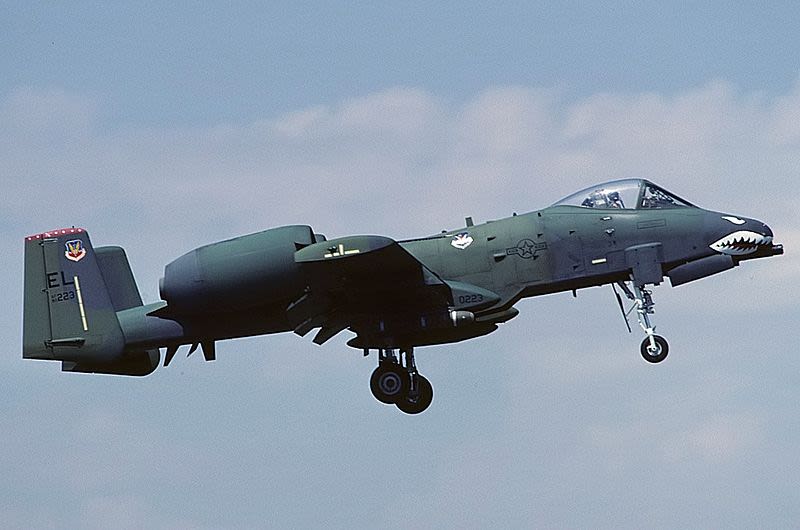
Following a fly-off between the two competing designs, the Air Force selected the YA-10 as the winner in April 1973 and took delivery of the first production A-10s in March 1976. At first, some Air Force pilots balked at the idea of flying low and slow over the battlefield, accustomed as they were to dogfights at high altitude. But in the Gulf War of 1990-1991, the Thunderbolt II, more commonly referred to as the Warthog, showed how it was truly worthy of its WWII P-47 Thunderbolt namesake. During the war, A-10s destroyed more than 900 Iraqi tanks, 2,000 military vehicles, and 1,200 artillery pieces. A-10 pilots even shot down two enemy helicopters. The Thunderbolt II maintained a stellar 95.7 percent mission-capability rate over 8,100 sorties. The Air Force was so impressed that they dropped any ideas of replacing the twenty-year-old aircraft at the time.
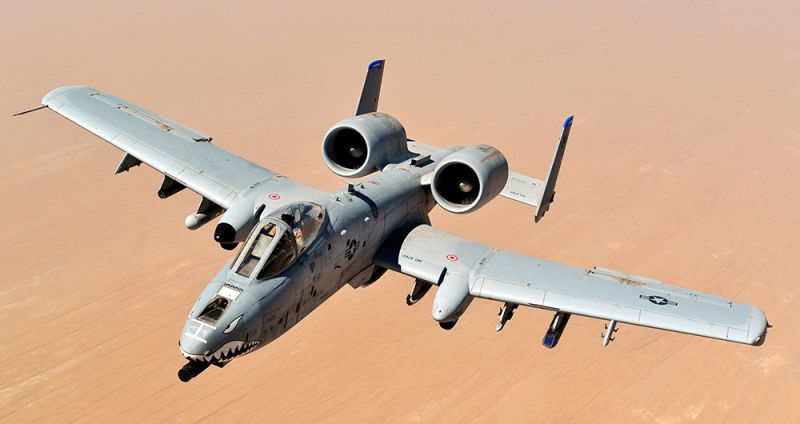
However, there are no guarantees in Washington DC, as Congress and the Air Force wrangled over how best to allocate limited funds. Despite continued excellent service in the low-intensity conflicts in Iraq, Afghanistan, and Syria, and with no true dedicated successor, the Air Force made plans to retire the A-10 to free up money for production of the Lockheed Martin F-35 Lightning II, a multi-role stealth aircraft that has yet to prove that it can live up to its WWII Lockheed P-38 Lightning heritage, or effectively perform the CAS role that is so brilliantly carried out by the A-10. In 2017, the US Congress stepped in and appropriated the money to keep the A-10 flying, and the 2019 budget included money to replace the wings on existing Warthogs. At least the for near future, the A-10 will continue to fly.
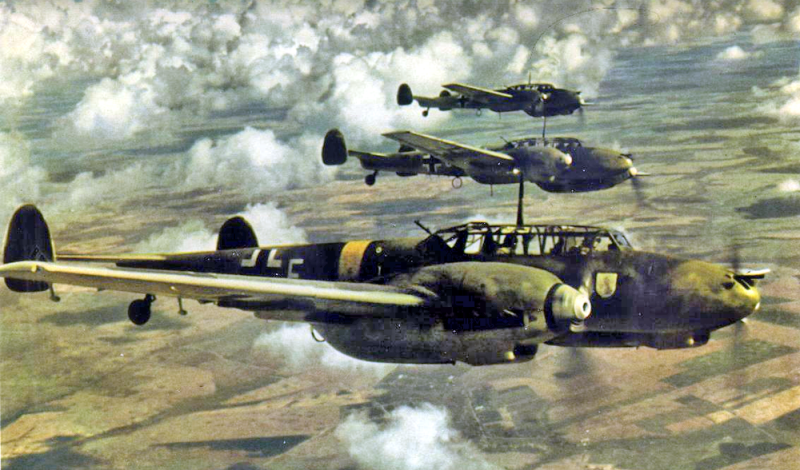
May 12, 1936 – The first flight of the Messerschmitt Bf 110 Zerstörer. The single-seat fighter had matured significantly during the Golden Age of Aviation in the 1930s, but a lack of adequate range was becoming the Achilles heel of fighters of the pre-WWII era. In an effort to make a warplane with greater range, designers began to consider twin-engine aircraft that could offer longer operational range along with the added benefit of greater firepower. When Adolf Hitler came to power in Germany in 1933, he already had his sights set on expanding German territory through his ongoing policy of lebensraum. But to do that, he first had to rebuild Germany’s ground and air forces that had been dismantled by the Treaty of Versailles which ended WWI. In 1935, Hermann Göring was appointed as the head of the fledgling Luftwaffe and became a vocal champion for the concept of the Kampfzerstörer (battle destroyer), a heavily armed aircraft that, theoretically at least, could smash through enemy fighter screens while also providing protection for larger bombers. Focke-Wulf, Henschel, Arado and Messerschmitt submitted prototypes for the new fighter-bomber, and even though designer Willy Messerschmitt omitted the internal bomb bay in order to increase range and speed, his design for the Bf 110 Zerstörer (Destroyer) was selected as the winner.
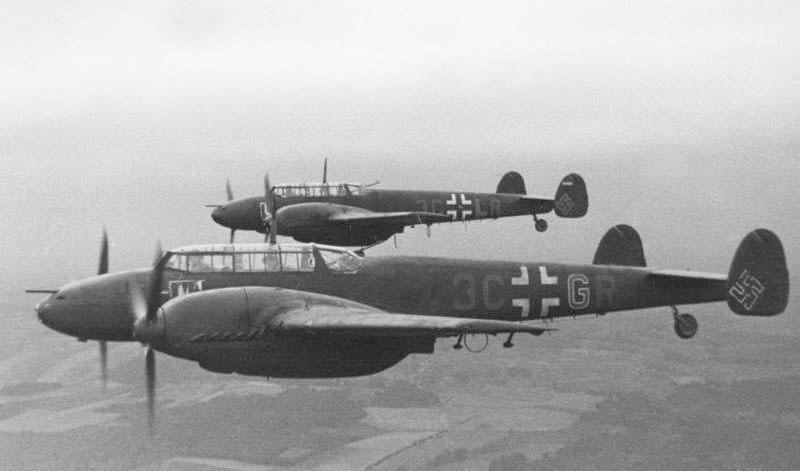
The Bf 110 wasn’t the most maneuverable aircraft (the Bf 110 is often erroneously referred to as the Me 110; “Bf” comes from Bayerische Flugzeugwerke, where Messerschmitt was chief designer), but its high speed allowed it to outpace the Messerschmitt Bf 109 fighter in service at the time. At first, the Zerstörer was produced in three basic variants: the B-1, which was armed with four 7.92 mm MG 17 machine guns and two 20mm MG FF cannons; the B-2 reconnaissance version, which replaced the two cannons with cameras while keeping the machine guns; and the B-3, which served as a trainer, with the cannons removed to make way for more radio equipment. Though the Bf 110 was fast for its time, and had good range, Luftwaffe planners knew that its service days were numbered, given the rapid pace of aircraft development. Even as Bf 110s were taking part in the invasion of Poland at the outbreak of WWII in 1939, its successor, the Messerschmitt Me 210, was ready for flight. However, the Me 210 suffered from serious teething problems, particularly with its aerodynamics, and was never produced in significant numbers. The Bf 110 was forced to soldier on throughout the war, where its weaknesses quickly became apparent.
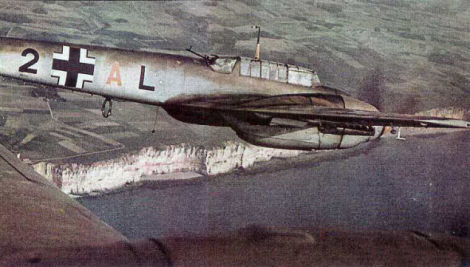
Though the Zerstörer served effectively in the Polish, Norwegian and French campaigns early in the war, the Battle of Britain showed that the Bf 110 was by no means a fighter, and it suffered bitterly as its pilots tried to protect German bombers attacking England. It was entirely unable to dogfight with the more agile Hawker Hurricane and Supermarine Spitfire, and its single defensive machine gun proved to be ineffective at fending off attackers. These weaknesses were mitigated by tactics such as diving on unsuspecting fighters from high altitude, but the Kampfzerstörer concept ultimately proved effective only on paper. On August 15, 1940, nearly 30 Bf 110s were lost in a single day of combat, and 23 more were lost over the next two days. But even with its impending obsolescence as a fighter, the Bf 110's days were not over.
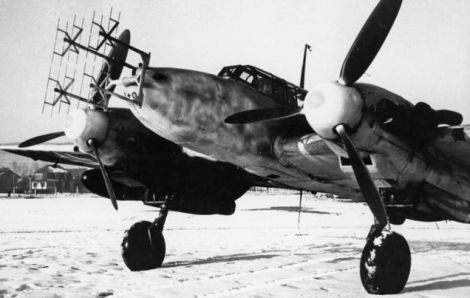
While it was eventually withdrawn from daylight fighting, the advent of the aerial Lichtenstein radar meant that the Bf 11o could now be turned into a potent night fighter, and it became the primary weapon of the German Nachtjagdgeschwader (night fighter wing) against British nighttime bombing raids. Some night-fighting 110s were armed with upward firing twin cannons, nicknamed Schrage Musik. Since the British bombers had no ventral turret, the 110s flew underneath the unsuspecting bombers and fired directly upward. In one instance, a Luftwaffe pilot dispatched four RAF bombers in just 30 minutes in this way. Though the Luftwaffe was ultimately unable to stop all the British bombers during their nighttime missions, radar-equipped Bf 110s exacted a heavy toll, with Germany’s top night fighter ace Major Heinz-Wolfgang Schnaufer claiming 121 victories with Nachtjagdgeschwader 1 and 4. In all, over 6,000 Bf 110s were produced, and while it never lived up to its original billing, the Zerstörer still played a vital role in the German Luftwaffe throughout the war in every theater of operations.
Short Takeoff
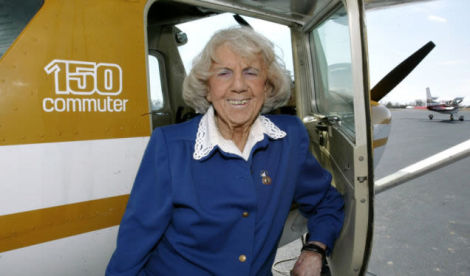
May 10, 2012 – The death of Evelyn Bryan Johnson. Johnson was born in Corbin, Kentucky on November 4, 1909 and began her flying career with the US Army Air Corps in 1944. By the time she quit flying at the age of 96 she had logged 57,635 flying hours, the international record for the greatest number of flying hours logged. Johnson served as a colonel in the Civil Air Patrol and as a flight instructor, garnering the distinction of being the oldest instructor pilot in the world and training more pilots and giving more FAA exams than any other instructor. On July 21, 2007, Johnson was inducted into the National Aviation Hall of Fame, joining Amelia Earhart, Jacqueline Cochran, Sally Ride, and other famous flyers.
May 10, 1991 – The first flight of the Bombardier CRJ100. The CRJ traces it roots back to 1989 with the beginning of the Canadair Regional Jet program which sought to develop a medium-range jet airliner to seat up to 52 passengers. The design was originally developed as a stretched variant of the Canadair Challenger CL-600 business jet and, following the CRJ100's entry into service, it was quickly developed into the CRJ200 ER and LR, each with increased range. The CRJ100, along with its larger CRJ200 variant, have proven very popular with smaller airlines, as well as some large airlines who use the regional jet to serve smaller airports. A total of 935 aircraft of both variants have been produced, and the airliner remains in service.

May 10, 1986 – The U. S. Navy adopts the McDonnell Douglas F/A-18 Hornet as the official airplane of the Blue Angels. The Blue Angels were founded in 1931, and one of the hallmarks of the flight demonstration squadron has always been that they fly the same combat aircraft currently in fleet service. The Blues began with the Grumman F6F Hellcat and F8F Bearcat following WWII, then transitioned to jets in 1949 flying the Grumman F9F Panther. Staying with Grumman, the Blues transitioned to the swept wing F-9 Cougar and then F-11 Tiger before adopting the McDonnell Douglas F-4 Phantom II in 1969. Next came the more economical Douglas A-4 Skyhawk, and finally the Blue Angels’ first fourth generation fighter, the F/A-18 Hornet. The Blues are scheduled to transition to the Boeing F/A-18E/F Super Hornet by the end of 2021.

May 10, 1978 – The first flight of the Dassault Mirage 2000. Based on the delta wing Mirage III, the Mirage 2000 was developed in the 1970s as a lightweight fighter to compete with the General Dynamics F-16 Fighting Falcon for the export market. Since the Mirage 2000 was based on an existing aircraft, the prototype was ready for its first flight in just 27 months. It displayed superb handling for a delta-wing aircraft, impressing spectators when it was unveiled at the 1978 Farnborough Airshow and demonstrating that it was indeed a viable competitor to its American challenger. The Mirage 2000 entered service in November 1982, and over 600 examples were produced.
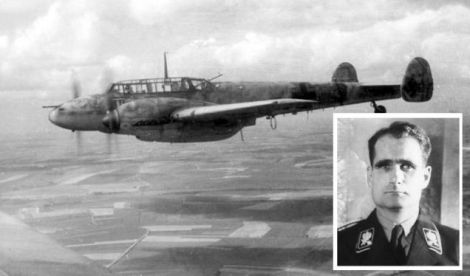
May 10, 1941 – Rudolf Hess parachutes into Scotland. Hess served as an infantryman and pilot in WWI, then rose to power with Adolf Hitler in the 1930s, eventually being named Deputy Führer in 1933. With the outbreak of WWII, Hess feared that Germany faced a ruinous war on two fronts, and he took it upon himself to broker peace with Great Britain. Taking off from Germany in a Messerschmitt Bf 110, Hess flew to Scotland and hoped to make contact with Douglas Douglas-Hamilton, 14th Duke of Hamilton, whom Hess mistakenly believed was opposed to the war in Europe. Chased by RAF fighters, Hess bailed out and was captured. He spent the remainder of the war as a British captive, and never met with British Prime Minister Winston Churchill. Though he was tried at Nuremberg after the war, Hess was not found guilty of war crimes; however, he spent the rest of his life in Spandau Prison, and died there in 1987 at the age of 93. The wreckage of his plane now resides in the Imperial War Museum.
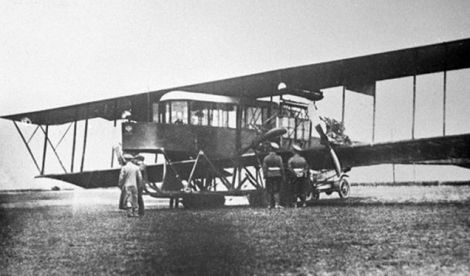
May 10, 1913 – The first flight of the Sikorsky Russky Vityaz. While Igor Sikorsky is best known in the West for his pioneering work with helicopters, he first made a name for himself in Russia with the construction of large civilian and military aircraft before emigrating to the US in 1919. The Russky Vityaz was powered by four Argus As I four-cylinder engines and had a top speed of 56 mph. It could carry up to seven passengers, and the fuselage was large enough that the passengers were able to move about the cabin during flight. Despite the promise of the Russky Vityaz, the sole aircraft was severely damaged when the engine of another airplane fell on it and crushed it. Rather than repair the aircraft, Sikorsky moved on to develop the even larger Ilya Muromets.
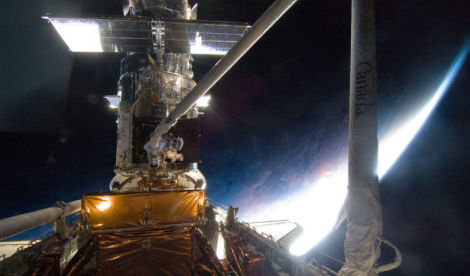
May 11, 2009 – The launch of Space Shuttle Atlantis on STS-125. When the Hubble Space Telescope (HST) was launched into Earth orbit in 1990, it was a landmark event that put a powerful telescope beyond the blurring effects of Earth’s atmosphere. Unfortunately, the HST had some significant flaws that hindered its capabilities, so NASA embarked on a series of five servicing missions flown by the Space Shuttle that captured the telescope in orbit and effected repairs. STS-125 was the fifth and final Hubble servicing mission (named Servicing Mission 4, as there was a mission 3A and 3B). The crew of Atlantis installed a new data-handling unit, repaired the Advanced Camera for Surveys and Space Telescope Imaging Spectrograph, replaced the batteries, and also installed the Wide Field Camera 3 and Cosmic Origins Spectrograph, repairs that finally rendered the HST fully operational. The crew also installed the Soft Capture Rendezvous System which will allow future manned or robotic missions to safely dispose of Hubble when its mission is complete.

May 11, 1934 – The first flight of the Douglas DC-2, a twin-engine airliner that was developed by the Douglas Aircraft Company to compete with the Boeing 247. When rival airline United Aircraft and Transport Corporation (later United Airlines) monopolized the purchase of the 247, Transcontinental and Western Air (later TWA) sought their own all-metal monoplane airliner. Douglas responded with the DC-1, which was quickly developed into the DC-2 with more powerful engines and room for 14 passengers. The DC-2 proved successful, but was ultimately overshadowed by its successor, the DC-3, which became one of the greatest aircraft in history in both military and civilian service. Just under 200 DC-2s were built and operated by airlines and militaries around the world.

May 11, 1932 – The airship USS Akron takes members of the ground crew into the air in a landing accident. During an attempted landing at Camp Kearny in San Diego, a sudden gust of wind caused the USS Akron (ZRS-4) to rise suddenly, and the mooring lines were cut to avoid a potentially catastrophic nose stand. As Akron rapidly ascended, four inexperienced groundcrew members clung to a mooring lines and were taken aloft. One quickly let go and fell roughly 15 feet, suffering a broken arm, while two others tried to hang on but ultimately fell to their death. The fourth, Seaman Apprentice Bud Cowart, managed to secure himself to the line and was eventually hoisted aboard the airship after an hour spent dangling beneath the airship. Newsreel footage captured the accident, along with the death of the two crewmen. The incident served as the inspiration for the first episode of the Adventures of Superman television program starring George Reeves as the red-caped superhero.
Connecting Flights
If you enjoy these Aviation History posts, please let me know in the comments. You can find more posts about aviation history, aviators, and aviation oddities at Wingspan.
